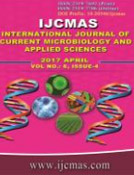


 National Academy of Agricultural Sciences (NAAS)
National Academy of Agricultural Sciences (NAAS)

|
PRINT ISSN : 2319-7692
Online ISSN : 2319-7706 Issues : 12 per year Publisher : Excellent Publishers Email : editorijcmas@gmail.com / submit@ijcmas.com Editor-in-chief: Dr.M.Prakash Index Copernicus ICV 2018: 95.39 NAAS RATING 2020: 5.38 |
Burn injury is a life-threatening event associated with both high morbidity and mortality. Burnarea provides a suitable site for bacterial multiplication and also becomes a more persistent richer source of infection, mainly because of the longer duration of patient stay in the hospital. The survival rates for burn patients have however improved substantially in the past few decades due to advances in modern medical care in specialized burn centers. The present study was undertaken to provide an insight to evaluate time related changes in microbial flora and their antibiotic susceptibility pattern occurring in the burn unit of Government Medical College and Hospital, Jammu from January 2013 to June 2013. The specimens were processed according to standard laboratory protocols, isolates were identified by conventional biochemical methods and antimicrobial susceptibility was performed by Kirby-Bauer disc diffusion method. A total of 63 patients were enrolled in the present study. Among these, 49(77.77%) (Showed evidence of burn wound infection whereas 14 (22.22%) (had no evidence of infection. Pseudomonas aeruginosa was the commonest pathogen isolated (27 %) followed by Klebsiella sp. (26%), S. aureus (17%), Proteus sp. (11%), Streptococcus sp. (10%), Enterococcus sp. and Enterobacter sp. (4%) respectively and Acinetobacter sp (1%). Gram-positive bacteria showed absolute resistance to Pencillin and absolute sensitivity to Vancomycin whereas in Gram negative bacteria 100% resistance to Ampicillin and 85.18% sensitivity to Piperacillin-Tazobactum was observed. There was a transition of bacterial growth from Gram-positive (Staphylococcus aureus being the most common) during the first week to Gram-negative (Pseudomonas species being the most common) in the subsequent weeks of stay. Gram positive bacteria and Gram negative bacteria were found sensitive to Vancomycin and Piperacillin-tazobactum.
 |
 |
 |
 |
 |